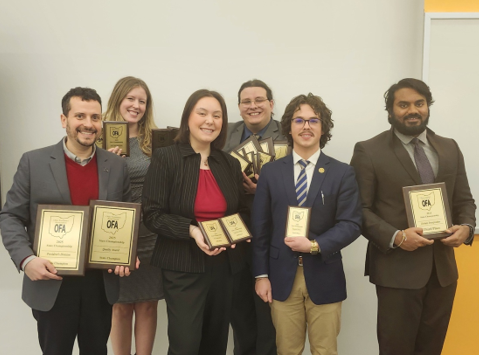Two weeks before the start of finals for the 2024 fall semester, University of Akron students found out that their school had initiated the retrenchment process.
While it has been no secret that the University of Akron has had financial difficulties in recent years, students were not expecting the news that their teachers may no longer be at UA.
The news may feel sudden, but the process of retrenchment is a long one.
“I would say the intent to retrench has been announced,” said Toni Bisconti, a professor of psychology and the faculty union president at the University of Akron.
“There’s lots of time for other proposals to be made,” said Bisconti. “For other solutions to be thought about.”
Retrenchment is a legal process written in the faculty contract that must be followed in order to reduce the workforce.
“From our perspective,” said Gwyneth Price, senior vice provost for Academic and Faculty Affairs. “It is the process that we would use in order to realign resources within faculty personnel.”
According to the contract, the president of UA must decide that one of five circumstances has been met to deem retrenchment necessary.
On Nov. 19, President R. J. Nemer sent a letter to Provost John Wiencek that lists the circumstances the president decided were met. Of the five possible circumstances, four were listed.
The first is that enrollment has declined over five academic semesters. Second, modification or elimination of an academic program has required reduction of faculty. Third, reorganization of a department that improves efficiency has reduced the need for faculty. Fourth, retrenchment is required from the action of the Ohio Department of Higher Education or Ohio General Assembly.
Once the provost was notified of the need to retrench, he decides the conditions and departments that need to be retrenched. The provost then tells the Akron American Association of University Professors and the deans of affected schools.
Once everyone involved has been notified, a Joint Committee on Retrenchment is formed.
“I have five working days to say these three people are going to be appointed to a committee,” said Bisconti.
The deans will also tell the chairs of the departments, who will inform faculty. The department faculty will then have ten days to have a formal response.
Bisconti asked for an extension on the department’s response and the administration approved. The department faculty had until Jan. 13, 2025 to respond.
The department response was a chance to make their case for why the department should not be retrenched.
According to Bisconti, the committee met for the first time on Wednesday, Dec. 4. From that first meeting, the committee has 30 working days to send the president a recommendation that can include how retrenchment can be avoided.
The specification of what kind of days are counted is important. Working days are only the days in the academic semesters, not including weekends or holidays.
Because of how close to the end of the semester this process happened, the 30 days paused for the winter break and began again on January 13. This means that the recommendation from the committee does not get sent to the president until the end of February.
Once the president has received the recommendations, he will send those recommendations along with his own to the Board. There is no time limit on how long the president can take to send the recommendations.
“It may look nothing like the proposal that was sent out,” said Bisconti.
Once the president sends the recommendations, the Board decides what is happening. If the board decides that retrenchment is needed, they also decide how many faculty members need to be retrenched.
If retrenchment is deemed necessary, the faculty contract outlines the order in which faculty can be released. Once it is determined that a faculty member is being released, the amount of time they have left at UA is decided by their position.
Throughout this entire process, from the president deciding that retrenchment is needed to the Board deciding that the process will happen, things can change.
Enrollment may increase. Faculty may retire. More money may be received that can cover the cost of keeping faculty. These things can all change the need for retrenchment or who needs to be retrenched.
“We’re looking at a variety of ways to try and address the financial situation, not just through retrenchment,” says Price. “But that is one tool we are using.”
It may not be until March that the process of retrenchment is started. For now, the faculty and AAUP is trying to find other ways to solve the problems that led to the president deciding retrenchment is needed.
As many people recall, the university made drastic cuts in response to COVID-19. The retrenchment process is not the same as what happened in 2020.
“What they did was they used the pandemic as the reason to declare what’s called force majeure,” said Bisconti.
According to the contract, the university is able to make immediate reductions to the workforce in response to catastrophic circumstances. This allowed the university to make cuts fast. The retrenchment process is much longer.
“We are looking at the long-term sustainability of the university,” said Price. “Not just the short term.”
Students can also have an effect on the retrenchment process. Without students, there is no school.
Since the announcement that retrenchment has been deemed necessary, many students have been vocal about their concern.
Bisconti thinks it is good for the administration to know what students think. However, now is not the time to be loud.
“Personally, I would try the approach of letter writing, petitions, that kind of thing first,” said Bisconti.
If retrenchment is still happening come March, that is when she recommends getting louder.
“I think if students treat it as though this is actually what’s happening, my fear is it’ll decrease enrollment more,” said Bisconti.
The process of retrenchment is long and while the proposed cuts are scary, nothing is set in stone.
“It’s a collaborative process,” said Price. “It’s, you know, it’s one that is most likely going to end in something at least slightly different than what was originally proposed.”
Should students want to let the administration know what they think, Price recommends students emailing the Office of Academic Affairs, OAA@uakron.edu.
















